Peugeot Bipper 2009 Repair Manual
Manufacturer: PEUGEOT, Model Year: 2009, Model line: Bipper, Model: Peugeot Bipper 2009Pages: 154, PDF Size: 4.02 MB
Page 61 of 154
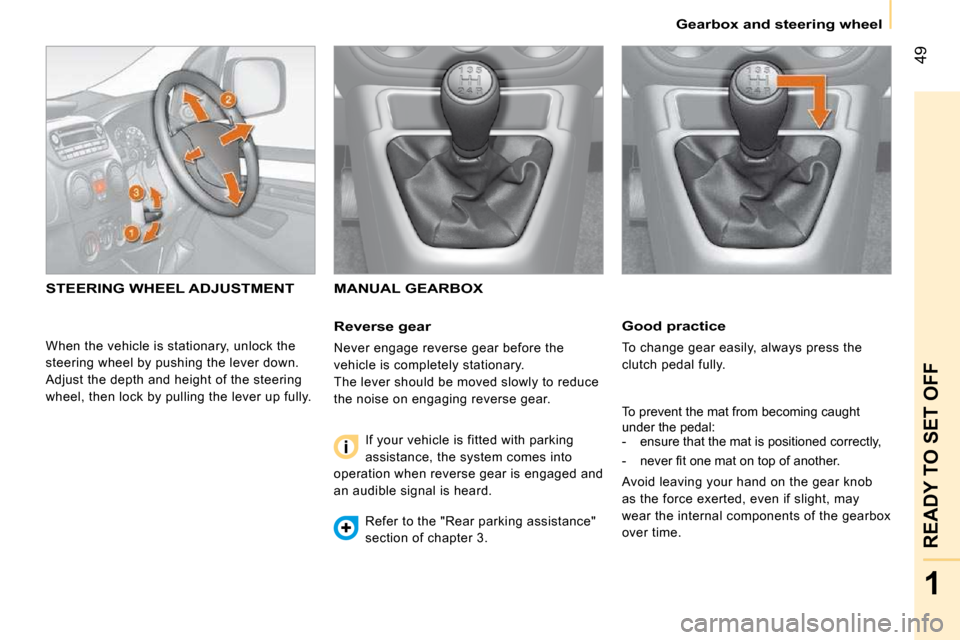
49
1
READY TO SET OFF
Gearbox and steering wheel
Good practice
To change gear easily, always press the
clutch pedal fully.
To prevent the mat from becoming caught
under the pedal:
- ensure that the mat is positioned correctly,
� � �-� � � �n�e�v�e�r� �fi� �t� �o�n�e� �m�a�t� �o�n� �t�o�p� �o�f� �a�n�o�t�h�e�r�.� � �
Avoid leaving your hand on the gear knob
as the force exerted, even if slight, may
wear the internal components of the gearbox
over time.
STEERING WHEEL ADJUSTMENT MANUAL GEARBOX
Reverse gear
Never engage reverse gear before the
vehicle is completely stationary.
The lever should be moved slowly to reduce
the noise on engaging reverse gear. If your vehicle is fitted with parking
assistance, the system comes into
operation when reverse gear is engaged and
an audible signal is heard.
Refer to the "Rear parking assistance"
section of chapter 3.
When the vehicle is stationary, unlock the
steering wheel by pushing the lever down.
Adjust the depth and height of the steering
wheel, then lock by pulling the lever up fully.
Page 62 of 154

50
Gearbox and steering wheel
PILOTED MANUAL GEARBOX
The five-speed piloted manual gearbox
offers a choice between the comfort of
automatic regulation or the pleasure of
manual gear changing.
This gearbox enables you to access two
driving modes:
- an automated mode for automatic control of the gears by the gearbox and therefore
without any action on the part of the
driver,
- a sequential mode for manual changing of the gears by the driver using the gear
lever.
It consists of a gear lever 1 on the centre
console for selecting the driving mode,
reverse gear and neutral or for changing
gear in sequential mode.
N: neutral.
With your foot on the brake, select this
position to start.
R: reverse gear.
With the vehicle stationary, keep your foot
on the brake pedal and push the gear lever
upwards.
A: automated mode.
Move the lever downwards to select this
mode.
M +/-: sequential mode with manual gear
changing.
Move the lever downwards, then to the left
to select this mode, then:
- push forward to change up,
- push rearward to change down.
Moving off
Select position N .
Press the brake pedal firmly while
starting the engine.
Start the engine. "N" appears on the
instrument panel display.
Select first gear (position M or A ) or reverse
(position R ).
Release the handbrake.
Release the brake pedal then accelerate.
"AUTO" and "1" or "R" appear on the
instrument panel display.
It is possible to move off in 2nd gear, in
sequential mode only.
Page 63 of 154
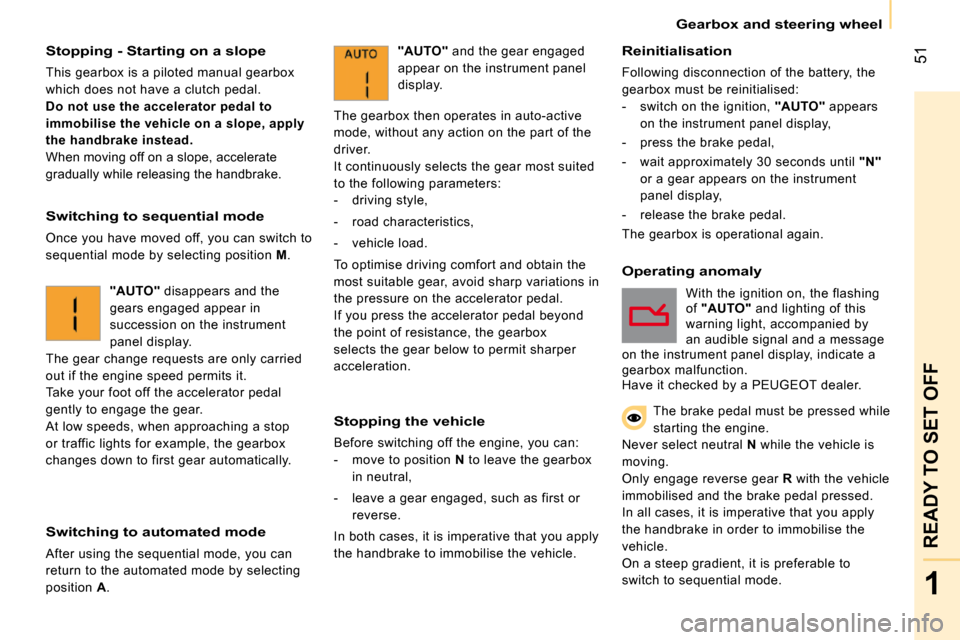
51
1
READY TO SET OFF
Gearbox and steering wheel
Stopping - Starting on a slope
This gearbox is a piloted manual gearbox
which does not have a clutch pedal.
Do not use the accelerator pedal to
immobilise the vehicle on a slope, apply
the handbrake instead.
When moving off on a slope, accelerate
gradually while releasing the handbrake.
Switching to sequential mode
Once you have moved off, you can switch to
sequential mode by selecting position M .
Switching to automated mode
After using the sequential mode, you can
return to the automated mode by selecting
position A .
Stopping the vehicle
Before switching off the engine, you can:
- move to position N to leave the gearbox
in neutral,
- leave a gear engaged, such as first or reverse.
In both cases, it is imperative that you apply
the handbrake to immobilise the vehicle.
Reinitialisation
Following disconnection of the battery, the
gearbox must be reinitialised:
- switch on the ignition, "AUTO" appears
on the instrument panel display,
- press the brake pedal,
- wait approximately 30 seconds until "N"
or a gear appears on the instrument
panel display,
- release the brake pedal.
The gearbox is operational again.
Operating anomaly
"AUTO" and the gear engaged
appear on the instrument panel
display.
The gearbox then operates in auto-active
mode, without any action on the part of the
driver.
It continuously selects the gear most suited
to the following parameters:
- driving style,
- road characteristics,
- vehicle load.
To optimise driving comfort and obtain the
most suitable gear, avoid sharp variations in
the pressure on the accelerator pedal.
If you press the accelerator pedal beyond
the point of resistance, the gearbox
selects the gear below to permit sharper
acceleration.
"AUTO" disappears and the
gears engaged appear in
succession on the instrument
panel display.
The gear change requests are only carried
out if the engine speed permits it.
Take your foot off the accelerator pedal
gently to engage the gear.
At low speeds, when approaching a stop
or traffic lights for example, the gearbox
changes down to first gear automatically. With the ignition on, the flashing
of
"AUTO" and lighting of this
warning light, accompanied by
an audible signal and a message
on the instrument panel display, indicate a
gearbox malfunction.
Have it checked by a PEUGEOT dealer.
The brake pedal must be pressed while
starting the engine.
Never select neutral N while the vehicle is
moving.
Only engage reverse gear R with the vehicle
immobilised and the brake pedal pressed.
In all cases, it is imperative that you apply
the handbrake in order to immobilise the
vehicle.
On a steep gradient, it is preferable to
switch to sequential mode.
Page 64 of 154
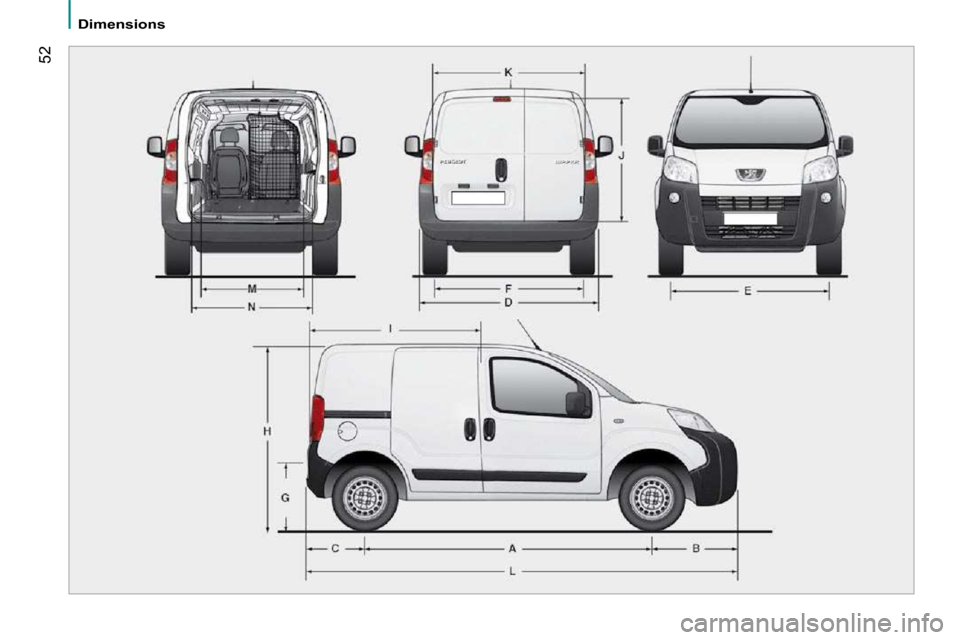
52
Dimensions
Page 65 of 154
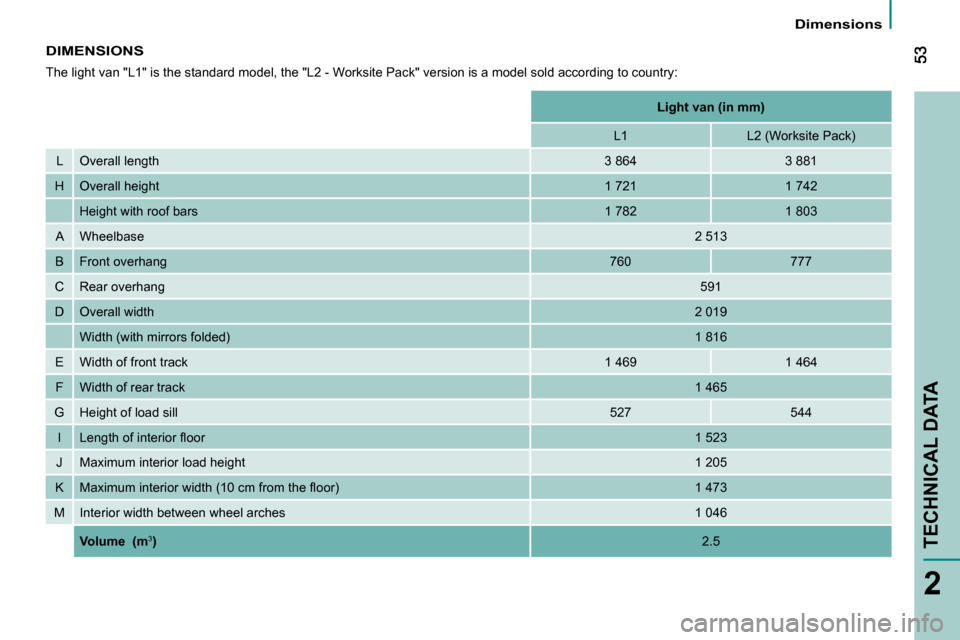
2
Dimensions
TECHNICAL DATA
DIMENSIONS
The light van "L1" is the standard model, the "L2 - Worksite Pack" version is a model sold according to country:
Light van (in mm)
L1 L2 (Worksite Pack)
L Overall length 3 864 3 881
H Overall height 1 721 1 742
Height with roof bars 1 782 1 803
A Wheelbase 2 513
B Front overhang 760 777
C Rear overhang 591
D Overall width 2 019
Width (with mirrors folded) 1 816
E Width of front track 1 469 1 464
F Width of rear track 1 465
G Height of load sill 527 544
I � �L�e�n�g�t�h� �o�f� �i�n�t�e�r�i�o�r� �fl� �o�o�r� 1 523
J Maximum interior load height 1 205
K � �M�a�x�i�m�u�m� �i�n�t�e�r�i�o�r� �w�i�d�t�h� �(�1�0� �c�m� �f�r�o�m� �t�h�e� �fl� �o�o�r�)� 1 473
M Interior width between wheel arches 1 046
Volume (m
3
) 2.5
Page 66 of 154
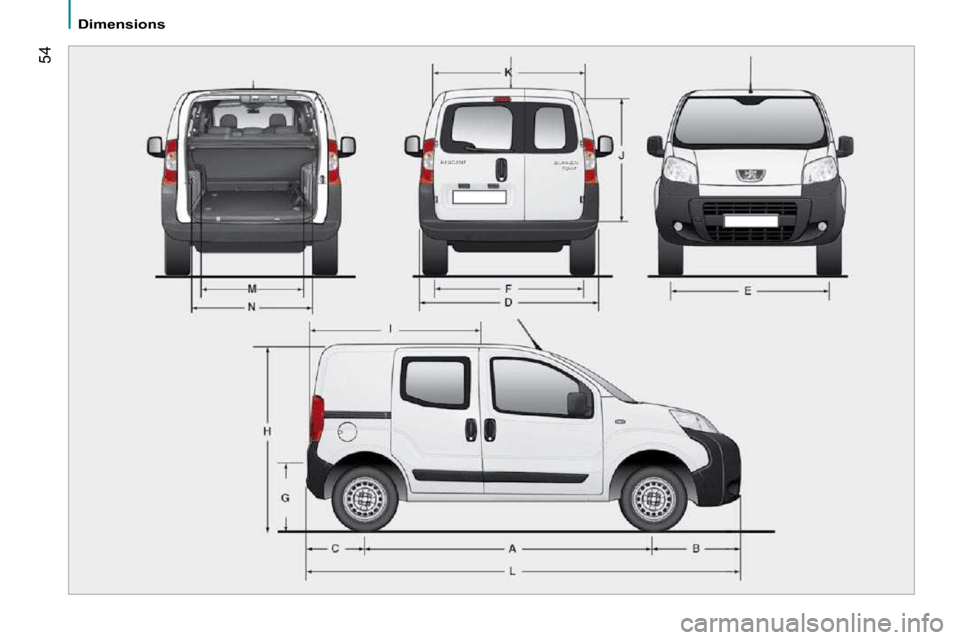
54
Dimensions
Page 67 of 154
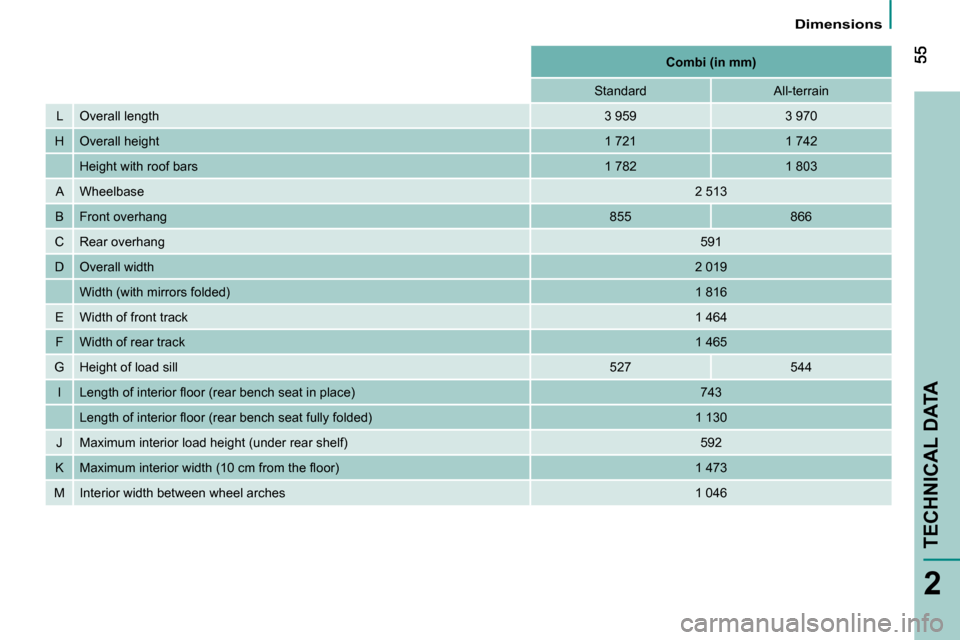
2
Dimensions
TECHNICAL DATA
Combi (in mm)
Standard All-terrain
L Overall length 3 959 3 970
H Overall height 1 721 1 742
Height with roof bars 1 782 1 803
A Wheelbase 2 513
B Front overhang 855 866
C Rear overhang 591
D Overall width 2 019
Width (with mirrors folded) 1 816
E Width of front track 1 464
F Width of rear track 1 465
G Height of load sill 527 544
I � �L�e�n�g�t�h� �o�f� �i�n�t�e�r�i�o�r� �fl� �o�o�r� �(�r�e�a�r� �b�e�n�c�h� �s�e�a�t� �i�n� �p�l�a�c�e�)� 743
� �L�e�n�g�t�h� �o�f� �i�n�t�e�r�i�o�r� �fl� �o�o�r� �(�r�e�a�r� �b�e�n�c�h� �s�e�a�t� �f�u�l�l�y� �f�o�l�d�e�d�)� 1 130
J Maximum interior load height (under rear shelf) 592
K � �M�a�x�i�m�u�m� �i�n�t�e�r�i�o�r� �w�i�d�t�h� �(�1�0� �c�m� �f�r�o�m� �t�h�e� �fl� �o�o�r�)� 1 473
M Interior width between wheel arches 1 046
Page 68 of 154
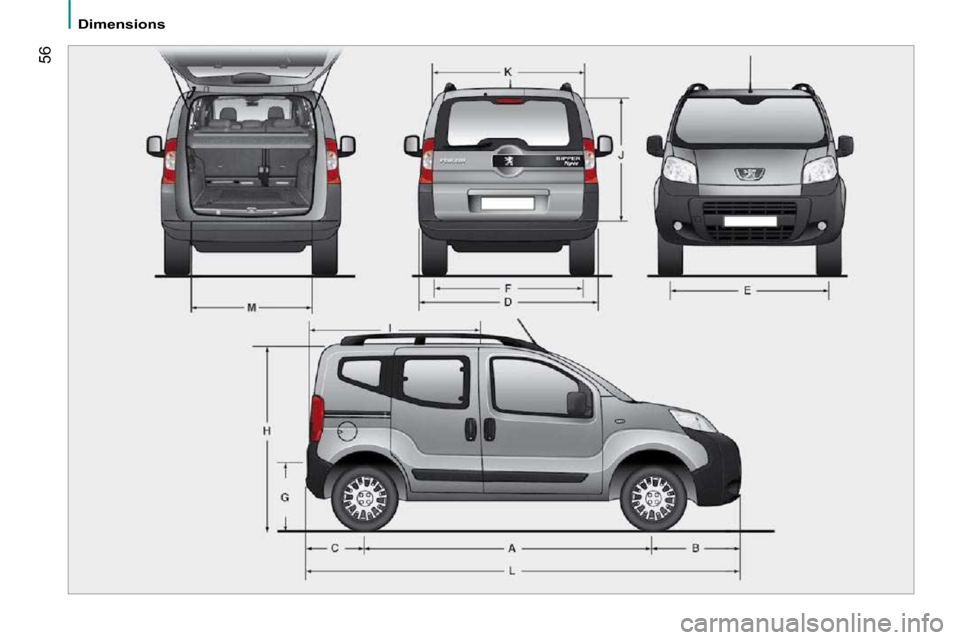
56
Dimensions
Page 69 of 154
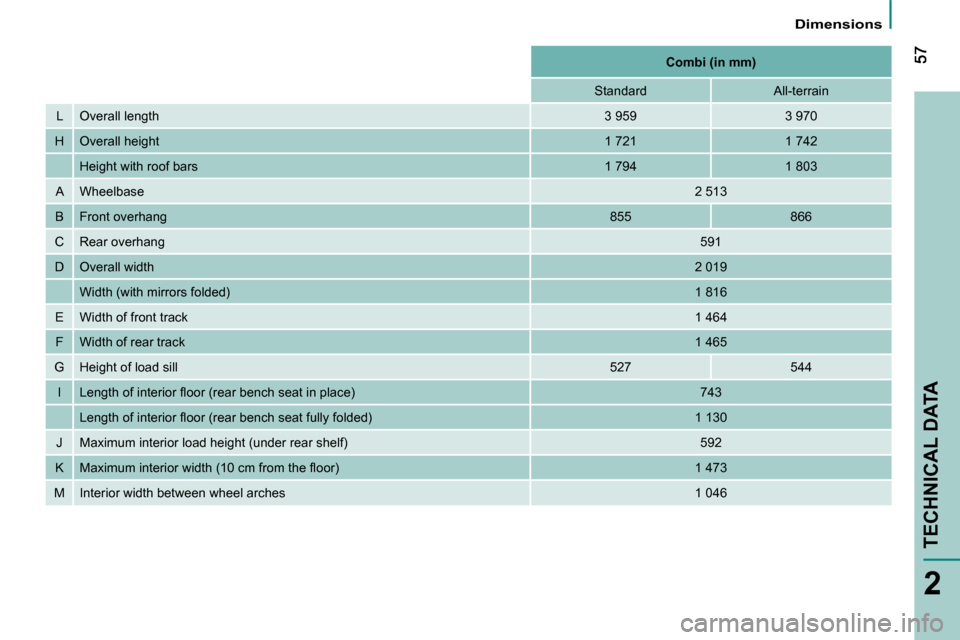
2
Dimensions
TECHNICAL DATA
Combi (in mm)
Standard All-terrain
L Overall length 3 959 3 970
H Overall height 1 721 1 742
Height with roof bars 1 794 1 803
A Wheelbase 2 513
B Front overhang 855 866
C Rear overhang 591
D Overall width 2 019
Width (with mirrors folded) 1 816
E Width of front track 1 464
F Width of rear track 1 465
G Height of load sill 527 544
I � �L�e�n�g�t�h� �o�f� �i�n�t�e�r�i�o�r� �fl� �o�o�r� �(�r�e�a�r� �b�e�n�c�h� �s�e�a�t� �i�n� �p�l�a�c�e�)� 743
� �L�e�n�g�t�h� �o�f� �i�n�t�e�r�i�o�r� �fl� �o�o�r� �(�r�e�a�r� �b�e�n�c�h� �s�e�a�t� �f�u�l�l�y� �f�o�l�d�e�d�)� 1 130
J Maximum interior load height (under rear shelf) 592
K � �M�a�x�i�m�u�m� �i�n�t�e�r�i�o�r� �w�i�d�t�h� �(�1�0� �c�m� �f�r�o�m� �t�h�e� �fl� �o�o�r�)� 1 473
M Interior width between wheel arches 1 046
Page 70 of 154

58
Engines
DIESEL ENGINE
1.4 HDi 70 bhp
Gearbox Manual Piloted manual
Gears 5
� �E�U� �s�t�a�n�d�a�r�d� �m�a�x�i�m�u�m� �p�o�w�e�r� �(�k�W�)� 50
� �C�u�b�i�c� �c�a�p�a�c�i�t�y� �(�c�m� � � � 3 ) 1 399
Bore x stroke (mm) 73.7 x 82
� �M�a�x� �p�o�w�e�r� �e�n�g�i�n�e� �s�p�e�e�d� �(�r�p�m�)� 4 000
EU standard max torque (Nm) 160
� �M�a�x� �t�o�r�q�u�e� �e�n�g�i�n�e� �s�p�e�e�d� �(�r�p�m�)� 1 750
Fuel Diesel
Catalytic converter Yes
�E�n�g�i�n�e� �o�i�l� �c�a�p�a�c�i�t�y� �(�i�n� �l�i�t�r�e�s�) 3.8